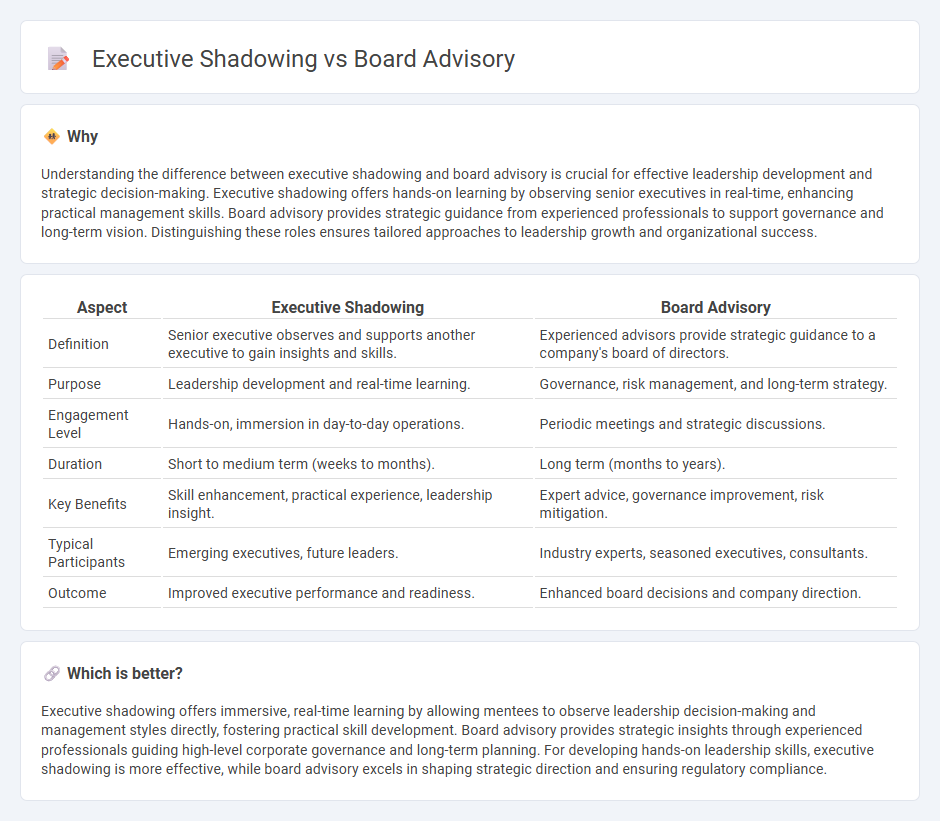
Executive shadowing offers personalized, real-time learning by closely observing senior leaders' decision-making and leadership styles within an organization. Board advisory provides strategic guidance and governance support to directors, enhancing board effectiveness and corporate oversight. Explore how these distinct consulting approaches can elevate your leadership capabilities and organizational performance.
Why it is important
Understanding the difference between executive shadowing and board advisory is crucial for effective leadership development and strategic decision-making. Executive shadowing offers hands-on learning by observing senior executives in real-time, enhancing practical management skills. Board advisory provides strategic guidance from experienced professionals to support governance and long-term vision. Distinguishing these roles ensures tailored approaches to leadership growth and organizational success.
Comparison Table
| Aspect | Executive Shadowing | Board Advisory |
|---|---|---|
| Definition | Senior executive observes and supports another executive to gain insights and skills. | Experienced advisors provide strategic guidance to a company's board of directors. |
| Purpose | Leadership development and real-time learning. | Governance, risk management, and long-term strategy. |
| Engagement Level | Hands-on, immersion in day-to-day operations. | Periodic meetings and strategic discussions. |
| Duration | Short to medium term (weeks to months). | Long term (months to years). |
| Key Benefits | Skill enhancement, practical experience, leadership insight. | Expert advice, governance improvement, risk mitigation. |
| Typical Participants | Emerging executives, future leaders. | Industry experts, seasoned executives, consultants. |
| Outcome | Improved executive performance and readiness. | Enhanced board decisions and company direction. |
Which is better?
Executive shadowing offers immersive, real-time learning by allowing mentees to observe leadership decision-making and management styles directly, fostering practical skill development. Board advisory provides strategic insights through experienced professionals guiding high-level corporate governance and long-term planning. For developing hands-on leadership skills, executive shadowing is more effective, while board advisory excels in shaping strategic direction and ensuring regulatory compliance.
Connection
Executive shadowing provides firsthand insights into leadership decision-making processes, enhancing the effectiveness of board advisory by aligning strategic recommendations with real-time executive perspectives. Board advisory leverages knowledge gained through executive shadowing to tailor governance practices and optimize organizational performance. This symbiotic relationship strengthens overall corporate strategy and leadership development.
Key Terms
**Board Advisory:**
Board advisory involves providing strategic guidance and expert insights to help organizations navigate complex decisions and drive long-term growth. This role emphasizes high-level governance, risk management, and performance optimization by partnering with the board of directors. Discover how leveraging board advisory can elevate your company's leadership and governance effectiveness.
Governance
Board advisory enhances governance by providing strategic insights and expert recommendations to the board, improving decision-making and risk management. Executive shadowing offers a practical governance perspective through direct observation of leadership behaviors and decision processes, fostering leadership development and alignment with governance standards. Explore the nuances of how board advisory and executive shadowing drive effective governance in organizations.
Strategic Oversight
Board advisory provides strategic oversight by guiding corporate governance and long-term vision, ensuring alignment with stakeholder interests and regulatory compliance. Executive shadowing offers hands-on experience, allowing emerging leaders to learn decision-making processes and leadership skills directly from executives. Explore how these approaches complement each other in fostering effective strategic oversight.
Source and External Links
What are Advisory Boards Roles and Responsibilities? - An advisory board provides an organization with expert advice and insights to solve problems or explore opportunities, typically consisting of a Chair, external advisors, and internal representatives, and focuses on advice rather than decision-making authority.
Key Differences Between an Advisory Board and Board of Directors - Advisory boards offer non-binding advice with no executive authority, unlike boards of directors which oversee operations, make decisions, and ensure legal compliance for the company.
Advisory board - Wikipedia - Advisory boards provide focused, strategic advice on specific issues without the pressures of executive decisions, serving as a 'safe harbor' for management to explore options before decisions are made by the board of directors.
 dowidth.com
dowidth.com